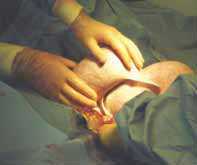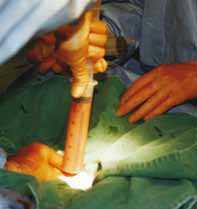Exploratory Laparotomy - Donkey
Indications for Exploratory Laparotomy


Exploratory laparotomy may be required in the donkey, as in the horse, for emergency or elective purposes, such as surgical colic, caesareans, and uro-genital surgery.
As discussed, colic in the donkey, especially impaction colic, may present with more subtle clinical signs than in a horse. However, acute signs of pain with nasogastric reflux and distended viscera are occasionally seen, and may indicate prompt surgical intervention. It is important to make an assessment of triglyceride levels and pancreatic enzymes as speedily as possible, as concurrent hyperlipaemia and/or pancreatitis will reduce the prognosis even if recognised and treated. Pancreatitis can present with signs of peracute pain in the anterior abdomen, which may be exacerbated by external ballotment behind the ventral sternum. In addition, peritoneal tap samples may show high levels of neutrophils, amylase and lipase.
Examination
The examination of the donkey with suspected surgical colic may be hampered due to the small size of the patient. A rectal examination is nearly always possible even if sedation is required. If this is truly impossible, ultrasound examination of the abdomen externally should be performed to assess viscera size, position and motility.
A peritoneal tap provides useful information; however most UK donkeys carry considerable fat deposits above the linea alba. If ultrasound is available, the depth of the peritoneal fat may be measured and an appropriate needle or (more safely) a teat cannula used.
In aged donkeys, a good assessment of dental disorders and possible chronic hoof disease should be made before surgery is contemplated. Our records show that internal neoplasia is also a significant complicating factor in geriatric donkeys. This should be taken into account and discussed with the donkey owner, especially if there has been a history of progressive weight loss, or unexplained changes in haematological/biochemical parameters. Despite all the warnings, donkeys have been successfully operated on for correctable surgical lesions, for example, small intestine strangulation and large colon displacements.
Urogenital surgery
Surgical correction of urogenital problems has been used at The Donkey Sanctuary for the following conditions: caesarean section, ovariohysterectomy for pyometra, ovary removal, bladder stone removal, and cryptorchidism. The approach required will depend on the surgery to be performed.
We have used
- flank laparotomy for unilateral ovarian removal
- paramedian approach for cryptorchidism
- ventral abdominal approach for colic and caesarean operations
The indications for, and treatment of, bladder stones and cryptorchidism are similar to those in the horse.
References
- Thiemann, A. (2008) Surgery In Svendsen, E.D., Duncan, J. and Hadrill, D. (2008) The Professional Handbook of the Donkey, 4th edition, Whittet Books, Chapter 16
|
|
This section was sponsored and content provided by THE DONKEY SANCTUARY |
|---|